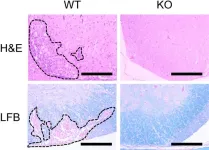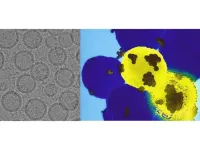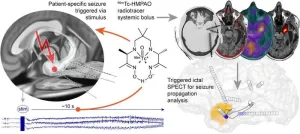(Press-News.org) Ultraviolet rays find diverse applications in medical and healthcare, serving purposes such as disinfection, sterilization, and therapy. They are also used in the semiconductor industry for creating microcircuits and patterns. A metalens fabrication process, developed by a team of researchers at Pohang University of Science and Technology (POSTECH), enables control over the optical properties of these UV rays. This innovation has garnered significant attention across industries, sparking interest in potential advancements.
A collaborative research team, comprising Professor Junsuk Rho from the Department of Mechanical Engineering and the Department of Chemical Engineering and PhD candidates Joohoon Kim and Yeseul Kim from the Department of Mechanical Engineering at POSTECH, and Professor Heon Lee and Wonjoong Kim from the Department of Materials Science and Engineering at Korea University, has devised a technique for the mass production of large-area metalenses tailored for use in the ultraviolet region. The findings of their research have been published in Materials Today, an international journal in the field of materials.
Metalenses control light properties through nanometer-scale patterns or structures on lens surfaces. With the ability to reduce the thickness of conventional lenses by a factor of 10,000, they hold significant promise in medical devices that are inserted in the body and wearable devices. Ongoing active research aims to achieve mass production and commercialization of metalenses.
However, ultraviolet light poses challenges as it is absorbed by most materials due to its high energy level. The shorter wavelength of ultraviolet light requires more structures for the same area. Furthermore, unlike visible and infrared light, the limited availability of materials transparent to ultraviolet light complicates the production of large-area metalenses. Additionally, nanoprocessing technology constraints have resulted in most reported metalenses for ultraviolet light being smaller than 500 μm (micrometers).
In prior research endeavors, the team collaborated with Dr. Gyoseon Jeon’s team at the Research Institute of Industrial Science and Technology (RIST) to achieve successful mass production of metalenses for visible light as published in Nature Materials, and for infrared light as recently reported in ‘Laser and Photonics Reviews’. The researchers extended their process by incorporating a zirconium oxide (ZrO2) material, transparent in the ultraviolet region, enabling the mass production of a metalense measuring 1 centimeter (cm) on a wafer. Employing a nano-imprinting process that engraves the pattern like a stamp, the team achieved the rapid and inexpensive production of metalenses that are 20,000 times larger than conventional ones.
Professor Junsuk Rho who led the research expressed the team's commitment by stating, "This marks the first instance of implementing a metalens with exceptional light-modulation capabilities over a large area in the ultraviolet region." He added, “We are committed to continually improving the technology for potential applications in industrial sectors such as semiconductor inspection equipment through further research efforts.”
The research was conducted with support from the N.EX.T Impact Project of POSCO Holdings, and the STEAM Research Program, the RLRC Program, the Nanomaterial Technology Development Program, and the Future Material Discovery Program of the Ministry of Science and ICT.
END
Have metalenses expanded their reach into the ultraviolet region?
2024-03-12
ELSE PRESS RELEASES FROM THIS DATE:
Key protein linked to immune disorders
2024-03-12
A new study highlights a potential therapeutic target for immune-related disorders, such as multiple sclerosis and asthma.
A new study has shed light on the importance of the protein STAP-1 in activating certain immune cells. Understanding the role of STAP-1 in these cells could give researchers a better glimpse into immune-related disorders and ways to treat them.
The researchers found that STAP-1 plays an important role in the activation of T cells, which are white blood cells that play a critical role in defending the body against infections and maintaining overall health. T cells are adept at recognizing foreign molecules that ...
COVID-19 had greater impact on life expectancy than previously known, but child mortality rates continued to decline during the pandemic
2024-03-12
**Embargo: 23:30 UK, 7:30 p.m. ET March 11, 2024**
***Please note the unusual embargo time for the United States due to daylight savings time***
Global Burden of Disease
COVID-19 had greater impact on life expectancy than previously known,
but child mortality rates continued to decline during the pandemic
A new study published in The Lancet reveals never-before-seen details about staggeringly high mortality from the COVID-19 pandemic within and across countries. Places such as Mexico City, Peru, and Bolivia had some of the largest drops in life expectancy from 2019 to 2021. The research, which presents updated ...
NSF CAREER Grant awarded to Dr. Jordon Gilmore Associate Professor of Bioengineering Clemson University
2024-03-12
Congratulations to Dr. Jordon Gilmore for receiving the prestigious NSF CAREER Award! The project is titled: "A Multi-phase Biosensing Approach towards Point-of-Care Evaluation of Pseudomonas aeruginosa Virulence in Infected Chronic Wounds". The project is in perfect alignment with the ADAPT in SC NSF Award. Dr. Gilmore is a co-leader of the the Explainable AI-Enabled Biomedical Devices for Diagnostics and Planning Applications, and the leader of the Broadening Participation and Diversity project areas of ADAPT in SC. In addition, he serves as a member of the ...
How do neural networks learn? A mathematical formula explains how they detect relevant patterns
2024-03-12
Neural networks have been powering breakthroughs in artificial intelligence, including the large language models that are now being used in a wide range of applications, from finance, to human resources to healthcare. But these networks remain a black box whose inner workings engineers and scientists struggle to understand. Now, a team led by data and computer scientists at the University of California San Diego has given neural networks the equivalent of an X-ray to uncover how they actually learn.
The researchers found that a formula used in statistical analysis provides a streamlined mathematical description of how neural networks, such as GPT-2, a precursor ...
Vaccine monitoring crucial as SARS-CoV-2 variants continue to evolve
2024-03-12
Researchers at the Francis Crick Institute and the National Institute for Health and Care Research Biomedical Research Centre at UCLH have highlighted the importance of continued surveillance of emerging SARS-CoV-2 variants and vaccine performance as the virus continues to evolve.
Published today as a research letter in The Lancet, their study compared the newer monovalent COVID vaccine, which specifically targets the XBB variant of Omicron (as recommended by the World Health Organisation), with older bivalent vaccines containing a mix of an Omicron variant and the original strain of COVID-19, which ...
Q&A: How Instagram influencers profit from anti-vaccine misinformation
2024-03-12
While Instagram might have a reputation for superficiality — a realm of exquisitely filtered images — it is now eclipsing other social media as a news source. The platform is increasingly filled with information, some of it pernicious and distributed via influencers.
Researchers at the University of Washington studied three prominent Instagram influencers spreading anti-vaccine misinformation as a route to profit. Each account occupies what lead author Rachel E. Moran, a UW senior research scientist at the Center for an Informed Public (CIP) and staff researcher in the ...
Nancy Brown recognized as one of Modern Healthcare’s ‘Top Women Leaders’
2024-03-12
DALLAS, March 11, 2024 — Nancy Brown, Chief Executive Officer of the American Heart Association, a global force for healthier lives for all and celebrating one hundred years of lifesaving service, has been recognized by Modern Healthcare as one of the Top Women Leaders for 2024.
The publication’s recognition program acknowledges and honors women executives from all sectors of the healthcare industry for their contributions to care delivery improvement, health equity, policy and gender equity in healthcare leadership.
Since 2008, Brown has served as CEO of the Association, which is celebrating its 100th birthday in 2024. Awardees were selected based ...
India's water problems set to get worse as the world warms
2024-03-12
Winter storms that provide crucial snow and rainfall to northern India are arriving significantly later in the year compared to 70 years ago, a new study has found, exacerbating the risk of catastrophic flooding while also reducing vital water supplies for millions of Indians.
The cyclonic storms, known as western disturbances, typically bring heavy snow to the Himalayas from December to March. This snowpack slowly melts in spring, providing a steady supply of irrigation water for wheat and other crops downstream.
The study, published today (Tuesday, 12 March 2024), in the journal Weather and ...
GPS nanoparticle platform precisely delivers therapeutic payload to cancer cells
2024-03-11
UNIVERSITY PARK, Pa. — A newly developed “GPS nanoparticle” injected intravenously can home in on cancer cells to deliver a genetic punch to the protein implicated in tumor growth and spread, according to researchers from Penn State. They tested their approach in human cell lines and in mice to effectively knock down a cancer-causing gene, reporting that the technique may potentially offer a more precise and effective treatment for notoriously hard-to-treat basal-like breast cancers.
They published their work today (March 11) in ACS Nano. They also filed a provisional application to patent the technology ...
New method for triggering and imaging seizures can help guide epilepsy surgery
2024-03-11
Researchers have developed a new method for triggering and imaging seizures in epilepsy patients, offering physicians the ability to collect real-time data to tailor epilepsy surgery. In contrast to previous practice, where physicians from neurology and nuclear medicine had to wait for hours to days in hopes of capturing the onset of a seizure, the new method is convenient, spares resources, and is clinically feasible. This research was published in the March issue of The Journal of Nuclear Medicine.
People with epilepsy and seizures who do not respond to medication are often helped by brain surgery. The goal ...




